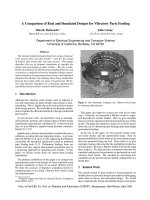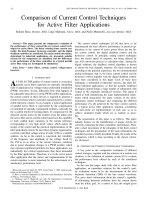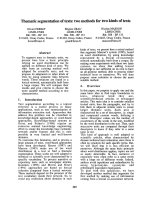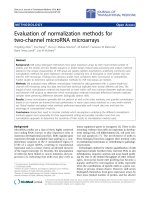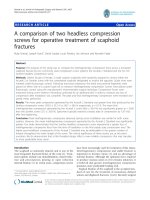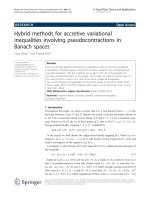Comparison of two methods for demodulation of pulse signals – Application in case of central sleep apnea
Bạn đang xem bản rút gọn của tài liệu. Xem và tải ngay bản đầy đủ của tài liệu tại đây (1.9 MB, 16 trang )
Vietnam Journal of Science and Technology 58 (3) (2020) 328-343
doi:10.15625/2525-2518/58/3/14640
COMPARISON OF TWO METHODS FOR DEMODULATION
OF PULSE SIGNALS – APPLICATION IN CASE OF CENTRAL
SLEEP APNEA
Le Page Ronan, Nguyen Quang Vinh, Goujon Jean-Marc, Poffo Luiz, Thual Monique
Universite Rennes, CNRS, Institut Foton, UMR 6082, F-22305, Lannion, France
*
Email:
Received: 22 November 2019; Accepted for publication: 16 February 2020
Abstract. In the field of 24/7 human health monitoring, pervasive computing makes possible the
continuous analysis of physiological parameters from an ambulatory device with a great
acceptability. This paper presents two methods for obtaining cardiac and respiratory rates from a
single arterial pressure signal: AM-FM demodulation and Singular Spectrum Analysis (SSA).
With the aim to monitor sleep apnea, two simulated central sleep apnea were performed and
recorded with Biopac reference system. The results showed a good evaluation of the cardiac rate
with Singular Spectrum Analysis and bad results with AM-FM demodulation. For the respiration
rate, some other signals were tested with average results for both methods. Further experiments
will deal with real sleep apnea cases and algorithm improvements.
Keywords: optical pulse signal, AM-FM demodulation, Singular Spectrum Analysis (SSA),
Heart and Respiratory Rates.
Classification numbers: 4.8.4, 4.9.3, 4.1.4.
1. INTRODUCTION
In the coming years, there will be a strong development of non-invasive physiological
devices for monitoring health conditions. Telecare and telemedicine are going to be more and
more employed, especially in developed countries. In our case, we have designed a device
comprised of an optical arterial pulse and mechanical sensors, worn at the wrist for a great
acceptability, which can be used to monitor people conditions (mainly heart and respiratory
rates). Our aim applications are physiological monitoring for elderly persons and sleep apnea
detection.
Central sleep apnea is a sleep disorder in which the brain doesn't send regular signals to
breathe, causing the breathing to pause and restart repeatedly during sleep. Methods for survey
are the important points in this case. Estimation of respiratory rate from physiological signals
has been investigated by many authors using various types of methods.
Among methods listed below, we will only focus on two different types of methods:
methods using demodulation techniques and methods using Principal Component Analysis
(PCA) techniques (or similar techniques).
Comparison of two methods for demodulation of pulse signals – application in case …
Several methods exist for respiration rate recovery from photoplethysmogram (PPG) signal,
for instance in [1 - 3], a basic way to extract breathing rate is carried out by signal filtering,
Addison et al. [4 - 11] use wavelet transform and Bruno et al. [12] propose AM-FM
demodulation.
While these methods are focusing on finding only the respiratory information from PPG,
other techniques need other physiological signals:
Iamratanakul et al. [13] propose a complex model that is used to recover respiration rate
thanks to 3 different signals: impedance between two electrocardiogram (ECG) leads,
arterial blood pressure and heart rate. The performance of a linear model combining the
three estimators (additive, AM, FM) is then evaluated.
Orphanidou [14] introduce a fusion method of ECG and PPG using Empirical Mode
Decomposition (EMD).
McNames and Aboy [15] describe an Extended Kalman Filter using a state model with
several parameters which is built to track information such as cardiac fundamental
frequency and higher harmonics, respiratory fundamental frequency and higher
harmonics, cardiac components harmonic amplitudes and phases, pulse pressure variation,
etc. Another Kalman model is used by Foussier et al. [16].
Jafari et al. [17] use MEMS-sensors combined with ICA and PCA methods.
Even if some of the above methods reached good achievements, these methods were not
tested specifically in case of sleep apnea, except the study of Fang et al. [18], where a
microphone is used with a smartphone in order to investigate cases of obstructive sleep apnea.
We are interested in finding a way to recover both heart rate and respiratory information
from a single arterial blood pressure signal. We also want to preserve a trade-off between
complexity and robustness.
In this paper, we study two different ways to obtain both heart and respiratory rates. These
parameters are parts of the arterial pulse signal thanks to the phenomenon called the Respiratory
Sinus Arrhythmia (RSA). The two investigated methods are:
• The AM-FM demodulation
• The Singular Spectrum Analysis
Each algorithm is detailed and is able to provide both cardiac and respiratory frequency
information. We compare the two algorithms in terms of mean error and standard deviation of
the cardiac frequency thanks to a reference signal obtained from another device. For the
respiration rate, due to the fact of the lack of reliable reference (motion noise), we have
evaluated over another free available database which provides reliable respiratory recorded
signals.
2. MATERIALS AND METHODS
2.1. Materials
We used the Biopac Systems Inc. MP100 device as the reference device with following
sensors and actuators:
• Optical photoplethysmography (PPG);
• Electrocardiogram (ECG);
• Respiration belt.
329
Le Page Ronan, Nguyen Quang Vinh, Goujon Jean-Marc, Poffo Luiz, Thual Monique
In order to assess the respiratory-induced changes in PPG and ECG signals when
simulating apnea, the subject held his breathing for approximately 70 seconds. Two trials were
performed and signals were recorded using Acknowledge Biopac Systems software. The
sampling rate was 500 Hz during the 12 minutes total duration of measurements. Data
processing was performed off-line using MatLab or C programs and libraries.
Figure 1 displays part of the 4 recorded signals for the study: 2 PPGs, 1 ECG and 1
respiration signals. ECG signal was used by AcqKnowledge software to calculate the reference
heart rate.
Figure 1. PPGs, ECG and respiration signals.
2.2. Analytical methods
2.2.1. AM-FM demodulation
In [12], cardiac and respiratory rhythms have been successfully extracted from a single
arterial pulse signal during sleep thanks to the AM-FM demodulation. In order to apply the
method to signals acquired in our labs, we used the algorithm described in Figure 2 to extract
heart and respiratory rates.
The pulse signal is first filtered through a second order Tchebychev filter. The AM-FM
demodulation is performed to get the instantaneous frequency composed of cardiac frequency
and an image of respiration signal. Then this signal is filtered and Fourier transform is
calculated. The frequency of maximum amplitude is attributed to respiratory rate. Moreover,
mean estimation in each RR interval (time duration between two consecutive peaks of the
signal) of the pulse signal is calculated in order to also get heart rate information.
AM-FM demodulation is performed using Teager energy operator [12, 19, 20]. Depending
on some constraints fulfilments, the discrete-time Teager energy operator, ψ, applied to the
discrete signal x[n], using Discrete-time Energy Separation Algorithm-1a (DESA-1a) proposed
by Maragos et al. [20], is simply expressed by:
(1)
330
Comparison of two methods for demodulation of pulse signals – application in case …
and gives directly the amplitude envelope a[n] and frequency component fi[n] of x[n]:
(2)
(3)
where Ts is the sampling period and x; [n] denotes the numerical differentiation of x[n].
Figure 2. AM-FM demodulation diagram.
An example of cardiac frequency estimation is given on Figure 3 with results obtained:
from PPG signal itself (RR intervals counting), from Biopac AcqKnowledge software (beat by
beat estimation) and from AM-FM demodulation (mean estimation in each RR interval); the
respiration signal is also drawn from respiration belt. During the simulated apnea, the heart rate
first decreases and then increases. We can notice that the AM-FM demodulation tends to
generally overestimate the heart rate and that the errors increase during the simulated apnea
episode.
331
Le Page Ronan, Nguyen Quang Vinh, Goujon Jean-Marc, Poffo Luiz, Thual Monique
Figure 3. (a) Results for cardiac rate estimation obtained from PPG signal (continuous line),
from AcqKnowledge Biopac Systems (thick dotted line) and from AM-FM demodulation
(thin dotted line); (b) Respiration signal from respiration belt.
2.2.2. Empirical SSA method
Singular Spectrum Analysis is a technique used for analyzing climatic time series [21-25].
The SSA is often used to enhance the Signal-to-Noise Ratio (SNR) or extract in the time series
the trends or oscillations in order to understand the inner dynamics or predict the system future
behavior. Among some interesting properties of SSA, we can also mention an iterative algorithm
that can be applied in signal with missing data [26]. SSA was recently used as a denoising preprocessing stage for Heart Rate estimation from PPG [27 - 30].
We develop an empirical method for cardiac and respiratory rates estimation using only a
single arterial pressure signal [31]. The algorithm used can be set as in Figure 4, with several
optional processing like denoising, single phase rectification (cf. Figure 5) or iterative procedure
when needed.
The original pulse signal x[n] of length N is cut in overlapping portion of length M. In other
words; we reshape the original signal into the trajectory matrix A, whose rows are vectors of
length M (sliding window over the signal x[n]).
SSA per orms a arhunen- o e decomposition o an estimate o the correlation matri
based on M lagged copies of the signal.
(4)
A key point is the choice of the length window M, for instance if we want to catch an
oscillation pattern whose period is L samples, then we should try a M > L. There is also a tradeoff with the calculation cost with large Error!. According to Vautard and Ghil [23], the value of
332
Comparison of two methods for demodulation of pulse signals – application in case …
M has to be chosen in the interval [1;N] (no optimal choice exists, so the value of M has to be
tested over a reasonable range).
Figure 4. Empirical algorithm with SSA for retrieving cardiac and respiratory information from an
arterial pressure signal, optional stages are represented with dashed line.
Figure 5. Original signal and single phase rectifier procedure, beginning and end of the upper
signal are set to zero in order to avoid side effects; the extracted envelope is also drawn.
The unbiased estimator of the lag covariance matrix C is calculated:
(5)
where i belongs to [0; M - 1].
333
Le Page Ronan, Nguyen Quang Vinh, Goujon Jean-Marc, Poffo Luiz, Thual Monique
Then a Singular Value Decomposition (SVD) is performed in order to obtain a diagonal
matrix of eigen values D sorted in decreasing order and a matrix of the associated eigen vectors V.
C = UDV
(6)
These eigen vectors are called Empirical Orthogonal Functions (EOFs) [22] or Direction of
Principal Components or Singular Vectors [32]. Reconstruction of the signal based upon a few
selected eigen vectors can be applied (see [24] for details). Usually, the first eigen value (or
vector) is associated with the AM modulation, the next two eigen values can generally be
associated with heart rate.
Another fact to be mentioned is that there are only a few eigen values with great value and
a lot of eigen values with small one (parsimonious representation), only a few eigen vectors
contain the majority of the signal energy, the others can be considered as noise contribution. It is
then possible to denoise by reconstructing the signal with the biggest eigen values while leaving
the meaningless ones.
Figures 6 and 7 show examples of SSA eigen values and eigen vectors extracted from a
pulse signal and compared to original signal and associated respiration signal. It can be seen that
respiration and first eigen value reconstructed signal are clearly highly correlated and it is the
same for the original arterial pulse signal with the second eigen value reconstructed signal.
Figure 6. Eigen values of SSA: only a few number of eigen values collect the major part of the
signal energy, and a few associated eigen vectors.
Figure 7. An example of demodulation performed by Singular Spectrum Analysis.
334
Comparison of two methods for demodulation of pulse signals – application in case …
2.2.3. Heart rate and respiratory rate extraction
We have identified at least three possibilities for extracting heart rate and respiratory
information after an SSA transform: a) Reconstruction of the signal based upon the basis of a
few selected eigen vectors (one or two values), then find each peak in this signal and then
calculate the Heart Rate [33]; b) Perform a Fast Fourier Transform (FFT) of the reconstructed
vector and find the frequency value of the spectrum maximum; c) Directly use the eigen values
with a scale factor correlated to M [23].
Figure 8 shows the processing results of one case in which respiration was held during
several seconds.
Figure 8. Heart rate estimation calculated with 3 methods thanks to SSA, heart rate reference given by
Acqknowledge Biopac software (top); Respiration signal with simulated apnea (bottom).
Figure 9. Examples of envelope extracted signals obtained from ECG (top) and PPG (bottom);
chest respiration signal reference (middle).
335
Le Page Ronan, Nguyen Quang Vinh, Goujon Jean-Marc, Poffo Luiz, Thual Monique
We have calculated the heart rate with the pre-cited methods involving SSA algorithm, they
are presented together with the heart rate calculated with Biopac. Even if some differences are
observed, the results seem to be robust enough, even during the apnea episode.
Figure 9 displays demodulated respiratory components extracted from ECG and PPG
signals compared to the respiration signal reference. It is proved that the SSA algorithm
performs also very well on ECG signals with very few modifications. It is also clear that during
the apnea episode, due to the lack of respiratory components, cardiac components are fully
represented in the first eigen vector.
3. RESULTS AND DISCUSSION
We compared both methods: SSA and AM-FM demodulation, using the two simulated
sleep apnea trials. Due to the fact of the lack of reliable respiratory reference, we are only able to
assess results with cardiac reference.
3.1. Comparison results for cardiac frequency
The Figure 10 shows an example of heart rate estimation using SSA scaled eigen value
method and AM-FM demodulation, where we can see that the AM-FM estimation of cardiac
frequency is not robust during the simulated sleep apnea episode.
Figure 10. (a) Cardiac rate estimation obtained from SSA scaled eigen value method
(thick continuous line), from AM-FM demodulation (dotted line) and from AcqKnowledge Biopac
Systems (thin continuous line); (b) Respiration signal with simulated apnea.
The results comparing AM-FM demodulation and SSA methods (FFT, scaled eigen value,
peak counting) for two trials are displayed in the Table 1. The mean error and the associated
standard deviation are calculated using the Acknowledge Biopac heart rate as a reference.
The heart rate estimation is respectively better with the SSA scaled eigen value, the SSA
eigen vector peak counting, the AM-FM demodulation, the SSA eigen vector FFT. The
336
Comparison of two methods for demodulation of pulse signals – application in case …
associated standard deviation is roughly the same for all methods.
During the time of simulated apnea, the heart rate estimation from AM-FM demodulation
gave wrong results, this is due to the fact that there is no respiratory contribution in the pulse
signal during this time. We can conclude that this kind of algorithm is not suitable for
monitoring people prone to central sleep apnea. Furthermore, all constraints defined in [12, 19,
20] are not always satisfied. So, it will not be possible to obtain an AM-FM demodulation of
arterial signals without errors.
Since the respiration evaluation was not concluded with our signals, we have tried it over
another free available database.
Table 1. Heart rate estimation obtained from AM-FM demodulation and SSA methods and compared
with reference (mean error and standard deviation in BPM (Beats Per Minute)).
Method
Mean error
Signal 1
Signal 2
Standard deviation
Signal 1
Signal 2
AM-FM demodulation
5.5
4.0
5.0
4.3
Eigen vector FFT
4.4
4.3
4.5
4.6
Scaled eigen value
0.2
-0.6
4.8
5.2
Eigen vector peak counting
0.3
-2.5
3.8
5.4
3.2. Test upon another database for respiration evaluation
Figure 11. Breathing rate obtained from respiration signal (peaks counting) and with SSA
scaled eigen value.
We have found a database which provides reliable respiratory recorded signals provided by
a pediatric intensive care center. The pediatric patient was suffering from a traumatic brain
injury. These signals can be found at the following url: Among the data we
have chosen 2 parameters only:
337
Le Page Ronan, Nguyen Quang Vinh, Goujon Jean-Marc, Poffo Luiz, Thual Monique
• Respiration: zipped te t ile, sampled at 125 Hz, units are scaled in the range [0;1023],
respiration signal sampling frequency 125 Hz,
• Pulse o imetry: one o the two signals rom a pulse o imeter sampled at 125 Hz, units are
scaled in the range [0;1023].
These data are characterized by high rates: cardiac around 200 beats per minute and
respiratory around 32 breaths per minute. The record lasted about 6 hours, we tested upon the
first hour only. The results for the respiration rates are drawn in Figures 11-13.
Figure 12. Breathing rate obtained from respiration signal (peaks counting) and with maximum value
of the FFT of the reconstructed signal.
Figure 13. Breathing rate obtained from respiration signal (peaks counting) and with peak counting
from reconstructed signal.
In fact, the SSA can extrapolate data [26], so some extra respiratory peaks are sometimes
been added while they should had not been, sometimes two are merged together. Some examples
of encountered difficult situations are illustrated on Figures 14 and 15.
338
Comparison of two methods for demodulation of pulse signals – application in case …
The mean error and standard deviation for respiration rate was computed using a peak
counting over the respiration signal as a reference. These results are presented in Table 2, where
the AM-FM demodulation presents the lower standard deviation, as oppose to the SSA scaled
eigen value that presents the highest standard deviation.
However, if we calculate the coefficient of variation (standard deviation/mean error i.e.
1.3/2.2= 0.6), we obtain a value inferior to 1 which indicates low variance, so maybe, if we can
compensate the error mean bias (which is not proven and need further investigation), then AMFM demodulation could be a suitable method when there is no apnea.
Figure 14. Examples of added extra peaks in reconstructed signal between 15 and 20 s.
Figure 15. Examples of problems occurring with saturated parts for the respiration and artifacts
for the arterial pulse signal.
339
Le Page Ronan, Nguyen Quang Vinh, Goujon Jean-Marc, Poffo Luiz, Thual Monique
Table 2. Respiratory rate estimation obtained from AM-FM demodulation and SSA methods and
compared with reference (mean error and standard deviation in BPM (Beats Per Minute)).
Method
Mean error
Standard deviation
AM-FM demodulation
2.2
1.3
Eigen vector FFT
3.5
3.7
Scaled eigen value
0.5
4.9
Eigen vector peak counting
-1.4
3.0
The complexity comparison of two methods is presented in Table 3. Although the SSA
method has a higher complexity than the AM-FM demodulation, it is not a limitative factor in
our application since the calculation power of embedded devices like smart wrist-watches or
smartphones has increased over the years and permits this calculation cost. Another drawback is
that eigen values have to be properly scaled in order to be fitted to the correct range of values. In
this case, eigen vectors can also be further exploited and can be used to help to set this scale
factor properly. This problem is currently under investigation since it can be solved in many
ways.
Table 3. Complexity comparison of two methods to physiological signal processing.
Method
Complexity
AM-FM demodulation
O(N log2 N)
SSA
O( M2 (N – M +1) )
SSA appears to be a powerful and promising tool for physiological signal processing with
great potential applications in monitoring, denoising or processing signals with missing data
[26]. SSA was also tested with ECG signals and showed performances similar to pulse signals.
4. CONCLUSIONS
The context of this study was to perform 24/7 ambulatory monitoring by developing a
device worn at the wrist with a great acceptability and which is able to retrieve heart and
respiration rate from a single arterial pressure signal. In this paper, we have compared two
methods for obtaining cardiac and respiratory rates from the single arterial pressure signal: SSA
and AM-FM demodulation. It was proved that the SSA method was more robust to retrieve
cardiac rate during apnea. We have adapted the SSA technique used in climatic time series
analysis in the case of arterial pulse rate analysis by adding some pre-processing stages which
are mandatory in order to succeed in catching the desired information: first a single phase
rectification had to be done, then a zero padding procedure at both extremities of the signal
window for a better matrix conditioning and computing.
Both methods were evaluated using 2 trials including a simulated sleep apnea episode: it
was shown that the AM-FM demodulation failed for estimating the heart rate during the apnea
episode. Respiration rate was evaluated using one hour of data from a pediatric patient with
traumatic brain injury. SSA has the advantages that it does not need a priori hypothesis about the
340
Comparison of two methods for demodulation of pulse signals – application in case …
type of the modulation in the signal (unlike the AM-FM demodulation) and then can efficiently
perform heart rate estimation during central sleep apnea.
The cardiac rate estimation using SSA eigen value is an interesting new way for obtaining
directly physiological frequency estimation without using FFT. Due to its flexibility,
improvements of the SSA method are expected in signals with missing data or noise.
Developing more complex algorithms is necessary to improve the accuracy of the actual
programs. Further trials will be employed to assess the methods with data including central,
obstructive or mixed sleep apnea cases.
Acknowledgements. The authors would li e to than the rench ational Grant Os o-Anvar and Prescom
Group for their support.
REFERENCES
1.
Prasetiyo R. B., Choi K. S., Yang G. H. - Design and implementation of respiration rate
measurement system using an information filter on an embedded device, Sensors 18
(2018) 4208. DOI: 10.3390/s18124208.
2.
Charlton P. H., Bonnici T., Tarassenko L., Alastruey J., Clifton D. A., Beale R.,
Watkinson P. J. - Extraction of respiratory signals from the electrocardiogram and
photoplethysmogram: technical and physiological determinants, Physiol Meas, IOP
Publishing 38 (5) (2017) 669–90. DOI: 10.1088/1361-6579/aa670e.
3.
Nilsson L., Johansson A. and Kalman S. - Respiration can be monitored by
photoplethysmography with high sensitivity and specificity regardless of anaesthesia and
ventilatory mode, Acta Anaesthesiologica Scandinavica 49 (8) (2005) 1157-1162.
DOI: 10.1111/j.1399-6576.2005.00721.x.
4.
Addison P. S. and Watson J. N. - Secondary Wavelet Feature Decoupling (SWFD) and its
use in detecting patient respiration from the photoplethysmogram, Engineering in
Medicine and Biology Society, 2003. Proceedings of the 25th Annual International
Conference of the IEEE, 2003, pp. 2602-2605. DOI: 10.1109/IEMBS.2003.1280448.
5.
Addison P. S. and Watson J. N. - Secondary Transform Decoupling of Shifted
Nonstationary Signal Modulation Components: Application to Photoplethysmography,
International Journal of Wavelets, Multiresolution and Information Processing 2 (1)
(2004) 43-57. DOI: 10.1142/S0219691304000329.
6.
Clifton D., Douglas J. G., Addison P. S. and Watson J. N. - Measurement of Respiratory
Rate From the Photoplethysmogram in Chest Clinic Patients, Journal of Clinical
Monitoring and Computing 21 (1) (2007) 55-61. DOI: 10.1007/s10877-006-9059-3.
7.
Leonard P. A., Beattie T. F., Addison P. S. and Watson J. N. - Standard pulse oximeters
can be used to monitor respiratory rate, Emergency Medicine Journal 20 (6) (2003) 524525. DOI: 10.1136/emj.20.6.524.
8.
Leonard P. A., Beattie T. F., Addison P. S. and Watson J. N. - Wavelet analysis of pulse
oximeter waveform permits identification of unwell children, Emergency Medicine
Journal 21 (1) (2004) 59-60. DOI: 10.1136/emj.2003.004887.
9.
Leonard P. A., Clifton D., Addison P. S., Watson J. N. and Beattie T. - An automated
algorithm for determining respiratory rate by photoplethysmogram in children, Acta
Paediatrica 95 (9) (2006) 1124-1128. DOI: 10.1080/08035250600612280.
341
Le Page Ronan, Nguyen Quang Vinh, Goujon Jean-Marc, Poffo Luiz, Thual Monique
10. Leonard P. A., Douglas J. G., Grubb N. R., Clifton D., Addison P. S. and Watson J. N. - A
Fully Automated Algorithm for the Determination of Respiratory Rate from the
Photoplethysmogram, Journal of Clinical Monitoring and Computing 20 (1) (2006) 33-36.
DOI: 10.1007/s10877-005-9007-7.
11. Leonard P. A., Grubb N. R., Addison P. S, Clifton D. and Watson J. N. - An Algorithm
for the Detection of Individual Breaths from the Pulse Oximeter Waveform, Journal of
Clinical Monitoring and Computing 18 (5) (2004) 309-312. DOI: 10.1007/s10877-0052697-z.
12. Bruno S. and Scalart P. - Estimation of cardiac and respiratory rhythms based on AM-FM
demodulation and an adaptive eigen vector decomposition, 13th European Signal
Processing Conference, 2005, pp. 05. HAL Id: inria-00482656.
13. Iamratanakul S., McNames J. and Goldstein B. - Estimation of respiration from
physiologic pressure signals, Engineering in Medicine and Biology Society, 2003.
Proceedings of the 25th Annual International Conference of the IEEE, 2003, pp. 27342737. DOI: 10.1109/IEMBS.2003.1280482.
14. Orphanidou C. - Derivation of respiration rate from ambulatory ECG and PPG using
ensemble empirical mode decomposition: Comparison and fusion, Computers in biology
and medicine 81 (2017) pp. 45–54 . DOI: 10.1016/j.compbiomed.2016.12.005
15. McNames J. and Aboy M. - Statistical Modeling of Cardiovascular Signals and Parameter
Estimation Based on the Extended Kalman Filter, IEEE Transactions on Biomedical
Engineering 55 (1) (2008) 119-129. DOI: 10.1109/TBME.2007.910648.
16. Foussier J., Teichmann D., Jia J., Misgeld B., and Leonhardt S. - An adaptive kalman
filter approach for cardiorespiratory signal extraction and fusion of non-contacting
sensors, BMC medical informatics and decision making 14 (1) (2014) p. 37.
DOI: 10.1186/1472-6947-14-37.
17. Jafari Tadi M., Lehtonen E., Teuho J., Koskinen J., Schultz J., Siekkinen R., Koivisto T.,
Pänkäälä M., Teräs M., and Klén R. - A computational framework for data fusion in
mems-based cardiac and respiratory gating, Sensors 19 (19) (2019) p. 4137.
DOI: 10.3390/s19194137.
18. Fang Y., Jiang Z., and Wang H. - A novel sleep respiratory rate detection method for
obstructive sleep apnea based on characteristic moment waveform, Journal of healthcare
engineering, vol. 2018, 2018. DOI: 10.1155/2018/1902176.
19. Maragos P., Kaiser J. and Quatieri T. - Energy separation in signal modulations with
application to speech analysis, IEEE Transactions on Signal Processing 41 (10) (1993)
3024-3051. DOI: 10.1109/78.277799.
20. Maragos P., Kaiser J. and Quatieri T. - On amplitude and frequency demodulation using
energy operators, IEEE Transactions on Signal Processing 41 (4) (1993) 1532-1550.
DOI: 10.1109/78.212729.
21. Broomhead D. S. and King P. - Extracting qualitative dynamics from experimental data,
Physica D: Nonlinear Phenomena 20 (2-3) (1986) 217-236. DOI: 10.1016/01672789(86)90031-X.
342
Comparison of two methods for demodulation of pulse signals – application in case …
22. Ghil M., Allen M. R., Dettinger M. D., Ide K., Kondrashov D., Mann M. E., Robertson A.
W., Saunders A., Tian Y., Varadi F. and Yiou P. - Advanced spectral methods for climatic
time series, Rev. Geophys 40 (1) (2002) 1003. DOI: 10.1029/2000RG000092.
23. Vautard R. and Ghil M. - Singular spectrum analysis in nonlinear dynamics, with
applications to paleoclimatic time series, Physica D: Nonlinear Phenomena 35 (3) (1989)
395-424. DOI: 10.1016/0167-2789(89)90077-8.
24. Vautard R., Yiou P. and Ghil M. - Singular-spectrum analysis: a toolkit for short, noisy
chaotic signals, Physica D: Nonlinear Phenomena 58 (1-4) (1992) 95-126.
DOI: 10.1016/0167-2789(92)90103-T.
25. Yiou P., Sornette D. and Ghil M. - Data-adaptive wavelets and multi-scale singularspectrum analysis, Physica D: Nonlinear Phenomena 142 (3-4) (2000) 254-290.
DOI: 10.1016/S0167-2789(00)00045-2.
26. Schoellhamer D. H. - Singular spectrum analysis for time series with missing data,
Geophysical Research Letters 28 (16) (2001) 3187-3190. DOI: 10.1029/2000GL012698
27. Zhang Z. - Photoplethysmography-based heart rate monitoring in physicalactivities via
joint sparse spectrum reconstruction, IEEE transactions on biomedical engineering 62(8)
(2015) pp. 1902–1910. DOI: 10.1109/TBME.2015.2406332.
28. Zhang Z., Pi Z., and Liu B. - Troika: A general framework for heart rate monitoring using
wrist-type photoplethysmographic signals during intensive physical exercise, IEEE
Transactions on biomedical engineering 62 (2) (2014) 522–531.
DOI: 10.1109/TBME.2014.2359372.
29. Zhang Z. - Heart rate monitoring from wrist-type photoplethysmographic (ppg) signals
during intensive physical exercise, in 2014 IEEE Global Conference on Signal and
Informat IEEE, 2014, pp. 698–702. DOI: 10.1109/GlobalSIP.2014.7032208.
30. Zhang Y., Liu B., and Zhang Z. - Combining ensemble empirical mode decomposition
with spectrum subtraction technique for heart rate monitoring using wrist-type
photoplethysmography, Biomedical Signal Processing and Control, vol. 21, pp. 119–125,
2015. DOI: 10.1016/j.bspc.2015.05.006
31. Nguyen Q. V., Le Page R., Goujon J. M., Guyader P. and Billon M. - Pulse rate analysis
in case of central sleep apnea: A new algorithm for cardiac rate estimation, Engineering in
Medicine and Biology Society, 2009. EMBC 2009, 31th Annual International Conference
of the IEEE, 2009, pp. 5490-5493. DOI: 10.1109/IEMBS.2009.5334561.
32. Schreiber T., Kantz H., Kurths J. and Mayer-Kress G. - Nonlinear analysis of
physiological data, Springer, 1998. DOI: 10.1007/978-3-642-71949-3
33. Carter T. A., Tapia R. A. and Papakonstantinou A. - An introduction to linear algebra for
pre-calculus students. Technical report, Rice University, May 1995.
343


